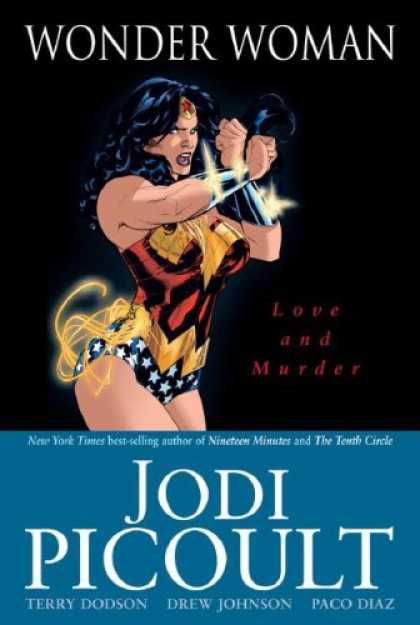Wonder Woman, v. 2: Love and War
Collects: Wonder Woman v. 3 #6-10 (2007)
Released: September 2007 (DC)
Format: 128 pages / hardback, color / $19.99 / ISBN: 9781401214876
This is the second Wonder Woman book I checked out from the Carrier Library. The big draw for Wonder Woman, v. 2: Love and Murder, judging from the cover, is that it is written by New York Times bestselling author Jodi Picoult. The name means nothing to me; more interesting is that Picoult claims in her introduction to be only the second woman to write Wonder Woman.
That can't be right, can it? But I guess it is. Strange. Well, how does this woman put her feminine mark on Wonder Woman?
 That's difficult to say. (Picoult tried to get rid of Wonder Woman's traditional bustier, but DC nixed that.) I'm not scholar enough or in touch with my feminine side to definitely say what's feminine or not. There's romance of a sort. A central conflict is between Wonder Woman and her mother; another is between Wonder Woman, the good girl, and Circe, the wicked wanton.
That's difficult to say. (Picoult tried to get rid of Wonder Woman's traditional bustier, but DC nixed that.) I'm not scholar enough or in touch with my feminine side to definitely say what's feminine or not. There's romance of a sort. A central conflict is between Wonder Woman and her mother; another is between Wonder Woman, the good girl, and Circe, the wicked wanton.
But it's also a story that has been firmly — and somewhat awkwardly — shoehorned into DC continuity, as a lead-in to the Amazons Attack miniseries. I have heard nothing good about that storyline, and from what I see here, that's not surprising.
Love and Murder starts with Wonder Woman as Diana Prince, agent of the Department of Metahuman Affairs. She's teamed with the shapeshifter Nemesis on an assignment to capture Wonder Woman, but something's fishy with Nemesis and Diana's boss, and Circe brings Wonder Woman's mother, Hippolyta, back from the dead while tormenting Wonder Woman in Washington, D.C., for some reason. And then there's a lot of fighting.
(I have to ask, do all Wonder Woman storylines end with a nuke pointed at Themiscyra? Because this is the second Wonder Woman book I've read, and it's the second time someone's tried to bomb the Amazons' island back into the Stone Age.)
There's a lot to like in this book. The government conspiracy angle is nicely done, although it's slightly abbreviated. The flirting between Nemesis and Wonder Woman / Diana Prince is fun to watch, but I'm not sure I believe it between these two characters; Wonder Woman is a pillar of goodness but slightly reserved, from all the indications I've received; Nemesis is morally gray at best, and shapeshifters are rarely trustworthy. Still, these elements make the first three issues enjoyable enough.
And then the emphasis shifts to the resurrected Hippolyta going nuts and attacking Washington, D.C., and all my interest goes out the window. The attack seems so arbitrary; Hippolyta's reasons for attacking Man's World against the advice of Athena (that tells you something there) are never fully brought out, making her a baffling (and uninteresting) cypher. Circe's plan seems so ... overinvolved, and it goes for naught — or seems to — when she monologues in front of the wrong people. Somehow, Love and Murder was transformed from a simple, enjoyable little story into a mess.
The art is from three different teams; Terry and Rachel Dodson are the featured team, but they only provide the art for issues #3 and 4. The Dodsons deliver what they always deliver: clear art and characters with prominent noselines and breastlines. Drew Johnson and Ray Snider, with the help of Rodney Ramos, do a credible Dodson imitation for #1 and 2 -- or I should say their art, while being distinct from the Dodsons', does mesh very well. Paco Diaz, who does the art chores for #5, is a departure from the rest of the book. On one hand, that doesn't matter, since by that point the story has devolved into a fight scene completely separate from the rest of the story, but Diaz doesn't do the best work with the fighting. Diaz does well with the battle royale scenes, giving a sense of the scale of the conflict away from the main players, but in the individual scenes, his bodies are often awkwardly positioned.
Perhaps it's my lack of knowledge of DC that makes me dislike this story, but the whiplash nature of the mid-book story change means I really can't recommend it to anyone.
Rating: ![]()
![]() (1.5 of 5)
(1.5 of 5)
Labels: 1.5, DC, Jodi Picoult, Washington DC, Wonder Woman





 The characters in The Loners (originally named "Excelsior") were brought together in the pages of
The characters in The Loners (originally named "Excelsior") were brought together in the pages of 